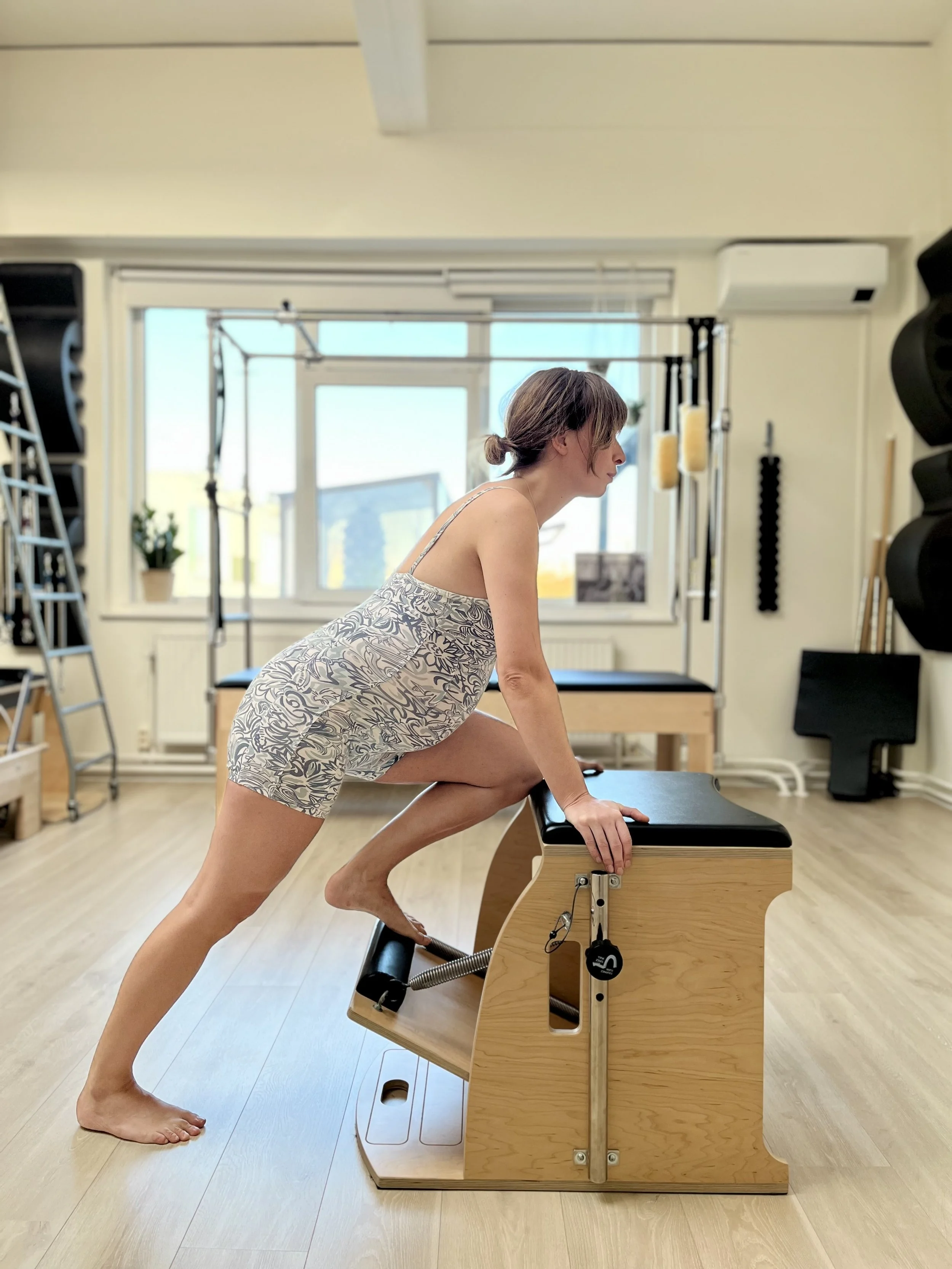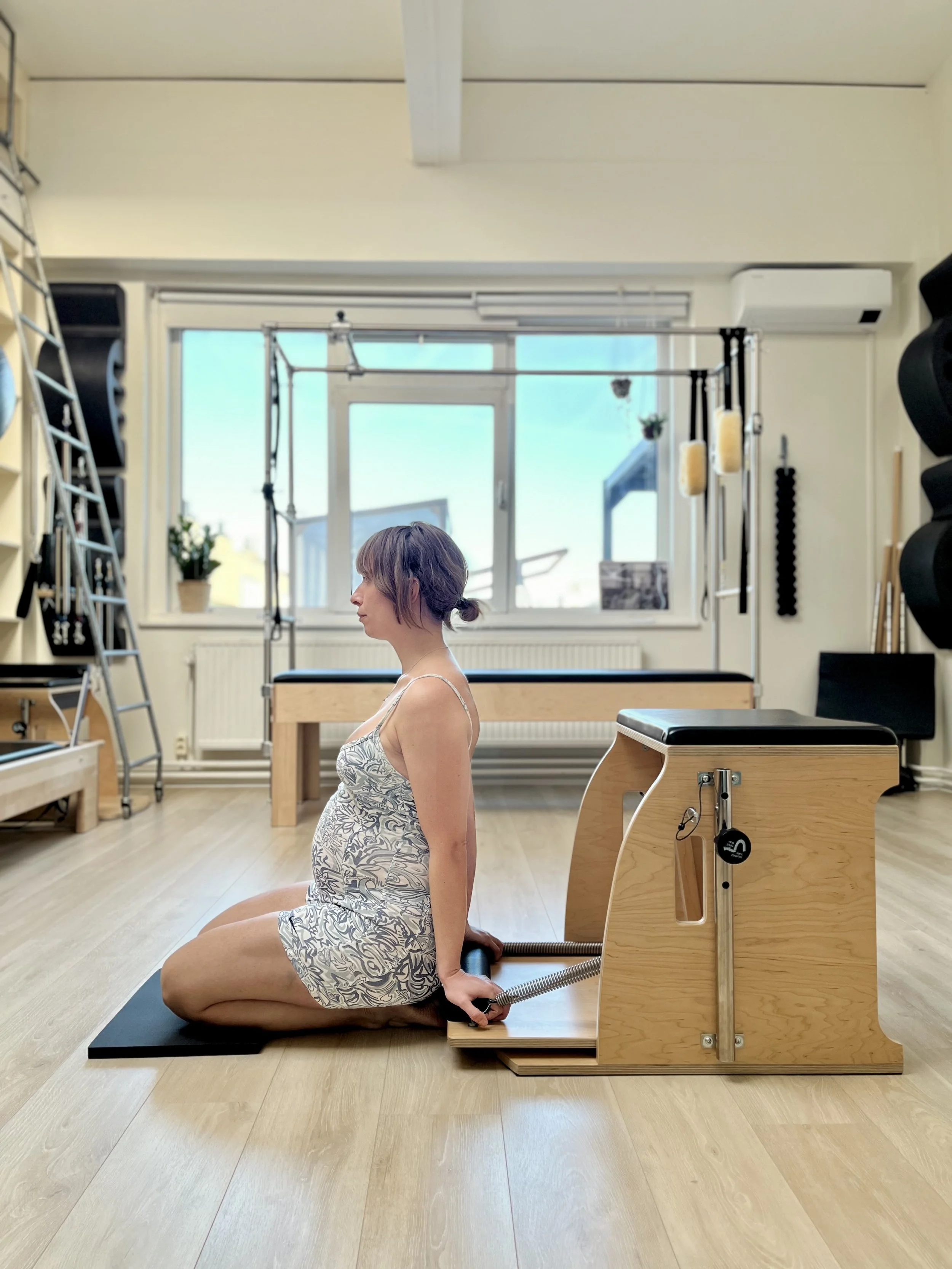pregnancy pilates
Have a look how a class of a 32 week pregnant body looks like.
Remember; all pregnancies are different, this is just an example, avoid comparing your self to anyone else but learn from your peers and how they manage their process.
Here’s a glimpse of a private Pilates session at Pilates Practice Amsterdam with our amazing client, who is 32 weeks pregnant. We tailor every exercise to support her strength, comfort, and confidence as her body continues to grow and change.
Footwork on the Reformer: This exercise focuses on the feet, the connection between the feet and the pelvic floor, gentle abdominal work, posture, and breathing. It’s a standard Pilates warm-up, perfectly adapted for pregnancy using the spine corrector, so the body feels comfortable and supported while lying down. This is one of the foot positions we work on, but there are several others (including working on a single leg) to ensure the feet are exercised in all directions, helping to prevent stiff toes, build calf strength, and improve coordination with the knees and hips.
Hip work on the Reformer: After childbirth, many bodies face challenges not only in reconnecting with the core but also with hip pain or groin overloading. Pregnancy brings massive changes to the hips, as the ligaments loosen and the pelvis adapts to support the growing baby, which can affect alignment, stability, and muscle balance.
During hip work, we focus on building a connection from the feet to the hips, practicing healthy range of motion, gentle abdominal engagement, posture, and breathing. We go through a variety of exercises with different leg setups to work the hips from multiple angles, helping to restore strength, mobility, and balance. We usually practice this on the wedge pillow to give the body the comfort of slight elevation and avoid feeling dizzy.
Back work on Reformer: Think you can’t extend your upper back during pregnancy? You can! The reformer provides the perfect setup. In the first photo, you see the exercise setup: the back is supported by the ball, while the hips and legs are working hard (it’s happening, even if it’s hard to see!).
In the second photo, you can see how to safely progress into an upper back extension — an important movement to keep your spine active throughout pregnancy. The challenge is that as the lower back is constantly pulled into extension to support the growing belly, the upper back tends to curve forward to balance it. With proper movement practice, you can keep both parts of your spine agile and strong, exactly as they should be.
This is a wonderful moment in class. Using the springboard, the springs provide gentle stretch and traction, allowing you to move into a deep round back without overusing your abdominals. It feels amazing and prevents from lower back pain.
Now we go even deeper into the hips! At this stage of class, it’s possible to gently swing sideways, which helps release the sides of your back. It feels incredible and also gives you the chance to explore the deep squat position — a movement that can be very useful during childbirth!
And more stretch for the hamstrings and lower back!
Moving on to upper back and arm strength, this is an example of a full series, which we always modify according to your energy level — adjusting the spring load, the number of exercises, and repetitions. We build on the work of gentle abdominal practice by supporting posture, working against the springs, incorporating deep breathing, and focusing on overall body alignment. By the end of the session, you’ll feel much more supported in your upper body, which often immediately reduces lower back tension and discomfort.
Back to footwork and now training on single leg on a standing position. A wonderful exercise for foot, calf and thigh strength.
The moment has arrived for ultimate joy: the side stretch! Using the Pilates chair in this case, you gently stretch your side abdominal muscles while lengthening in both directions, creating more space for the baby! Everyone feels a little lighter — and the baby is happy too!
In the final exercise, we focus on shoulder blade mobility and stability, moving into a concluding upper back extension. At this stage, you can experience a greater range of motion than earlier in the reformer. The mid-back is activated and elongated, performing extension safely without putting strain on the lower back.
And a final rest to come back to your body followed by a big hug from your teacher for doing such a great work!











